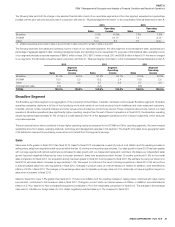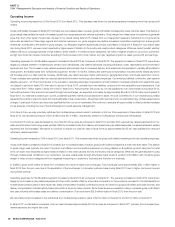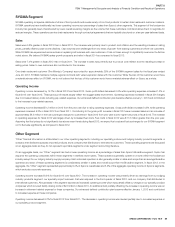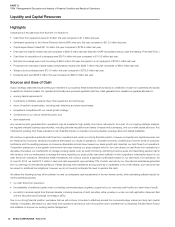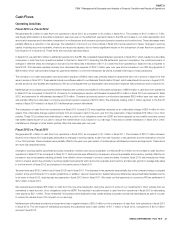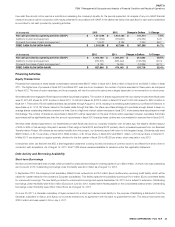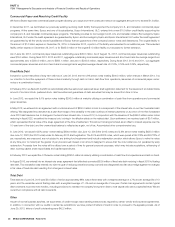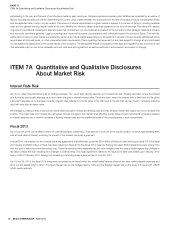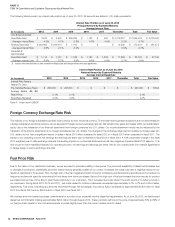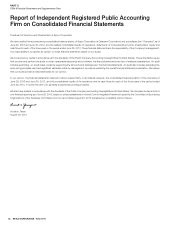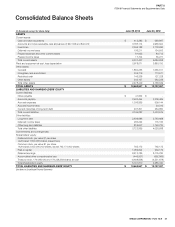Sysco 2013 Annual Report Download - page 48
Download and view the complete annual report
Please find page 48 of the 2013 Sysco annual report below. You can navigate through the pages in the report by either clicking on the pages listed below, or by using the keyword search tool below to find specific information within the annual report.SYSCO CORPORATION-Form10-K 37
PARTII
ITEM7Management’s Discussion and Analysis of Financial Condition and Results of Operations
The expected long-term rate of return on plan assets of the Retirement Plan was 7.75% for scal 2013 and scal 2012. The expectations of future returns
are derived from a mathematical asset model that incorporates assumptions as to the various asset class returns, re ecting a combination of historical
performance analysis and the forward-looking views of the nancial markets regarding the yield on bonds, historical returns of the major stock markets and
returns on alternative investments. Although not determinative of future returns, the effective annual rate of return on plan assets, developed using geometric/
compound averaging, was approximately 7.4%, 7.4%, 2.8%, and 15.4%, over the 20-year, 10-year, 5-year and 1-year periods ended December31,2012,
respectively. In addition, in eight of the last 15 years, the actual return on plan assets has exceeded 10%. The rate of return assumption is reviewed annually
and revised as deemed appropriate.
The expected return on plan assets impacts the recorded amount of net pension costs. The expected long-term rate of return on plan assets of the
Retirement Plan is 7.75% for scal 2014. A 100 basis point increase (decrease) in the assumed rate of return for scal 2014 would decrease (increase)
Sysco’s net company-sponsored pension costs for scal 2014 by approximately $24.9million.
Pension accounting standards require the recognition of the funded status of our de ned bene t plans in the statement of nancial position, with a
corresponding adjustment to accumulated other comprehensive income, net of tax. The amount re ected in accumulated other comprehensive loss related
to the recognition of the funded status of our de ned bene t plans as of June29,2013 was a charge, net of tax, of $575.2million. The amount re ected
in accumulated other comprehensive loss related to the recognition of the funded status of our de ned bene t plans as of June30,2012 was a charge,
net of tax, of $823.9million.
We made cash contributions to our company-sponsored pension plans of $93.6million and $162.4million in scal years 2013 and 2012, respectively.
The $70.0million contribution to the Retirement Plan in scal 2013 was voluntary, as there was no minimum required contribution for the calendar 2012
plan year to meet ERISA minimum funding requirements. The $140.0million contribution to the Retirement Plan in scal 2012 exceeded the minimum
required contribution for the calendar 2011 plan year to meet ERISA minimum funding requirements. There are no required contributions to the Retirement
Plan to meet ERISA minimum funding requirements in scal 2014. The estimated scal 2014 contributions to fund bene t payments for the SERP plan
are approximately $26million.
Income Taxes
The determination of our provision for income taxes requires signi cant judgment, the use of estimates and the interpretation and application of complex
tax laws. Our provision for income taxes primarily re ects a combination of income earned and taxed in the various U.S. federal and state, as well as foreign
jurisdictions. Jurisdictional tax law changes, increases or decreases in permanent differences between book and tax items, accruals or adjustments of
accruals for unrecognized tax bene ts or valuation allowances, and our change in the mix of earnings from these taxing jurisdictions all affect the overall
effective tax rate.
Our liability for unrecognized tax bene ts contains uncertainties because management is required to make assumptions and to apply judgment to estimate
the exposures associated with our various ling positions. We believe that the judgments and estimates discussed herein are reasonable; however, actual
results could differ, and we may be exposed to losses or gains that could be material. To the extent we prevail in matters for which a liability has been
established, or pay amounts in excess of recorded liabilities, our effective income tax rate in a given nancial statement period could be materially affected.
An unfavorable tax settlement generally would require use of our cash and may result in an increase in our effective income tax rate in the period of resolution.
A favorable tax settlement may be recognized as a reduction in our effective income tax rate in the period of resolution.
Vendor Consideration
We recognize consideration received from vendors when the services performed in connection with the monies received are completed and when the
related product has been sold by Sysco. There are several types of cash consideration received from vendors. In many instances, the vendor consideration
is in the form of a speci ed amount per case or per pound. In these instances, we will recognize the vendor consideration as a reduction of cost of sales
when the product is sold. In some instances, vendor consideration is received upon receipt of inventory in our distribution facilities. We estimate the
amount needed to reduce our inventory based on inventory turns until the product is sold. Our inventory turnover is usually less than one month; therefore,
amounts deferred against inventory do not require long-term estimation. In the situations where the vendor consideration is not related directly to speci c
product purchases, we will recognize these as a reduction of cost of sales when the earnings process is complete, the related service is performed and
the amounts realized. Historically, adjustments to our estimates related to vendor consideration have not been signi cant.
Goodwill and Intangible Assets
Goodwill and intangible assets represent the excess of consideration paid over the fair value of tangible net assets acquired. Certain assumptions and
estimates are employed in determining the fair value of assets acquired, including goodwill and other intangible assets, as well as determining the allocation
of goodwill to the appropriate reporting unit.


